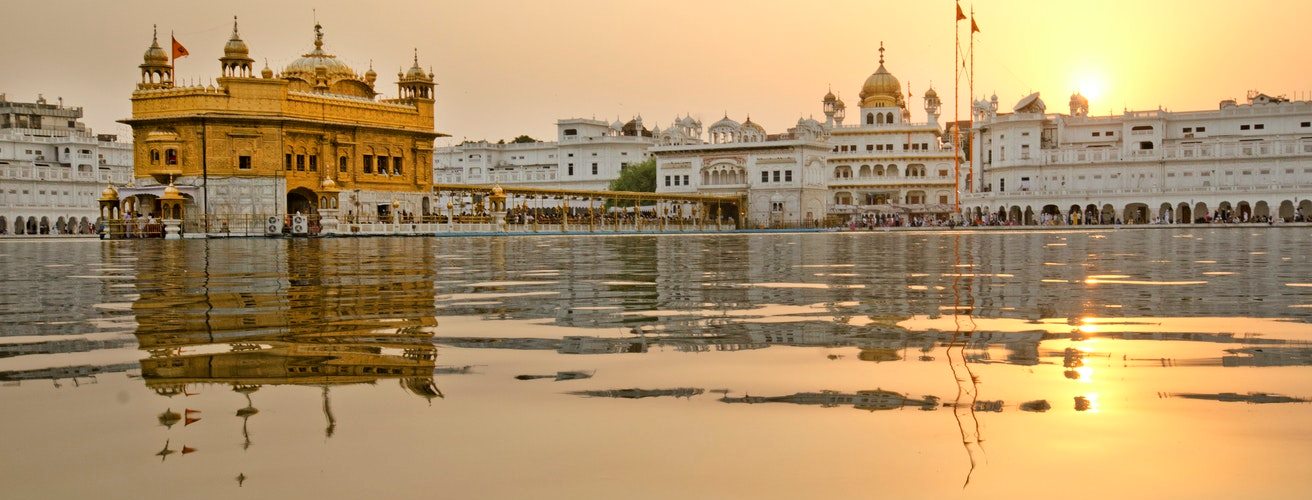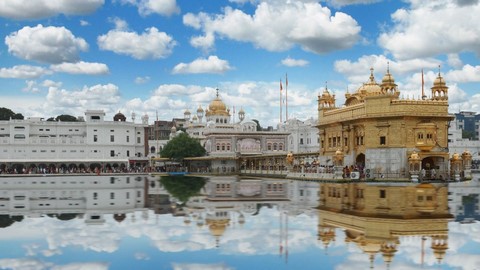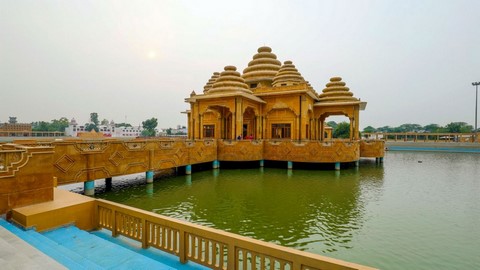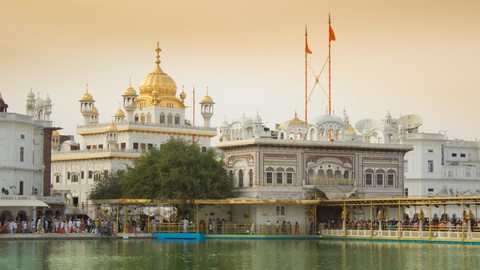Amritsar, a city of profound historical and cultural significance, has roots tracing back to the ancient Indus Valley Civilization. References to this region can be found in the Ramayana, where it is believed to be the birthplace of Lav and Kush, the sons of Lord Rama and Sita. However, Amritsar’s transformation into a major spiritual and cultural center began in the 16th century with the founding of the city by Sri Guru Ramdas Ji, the fourth Sikh Guru, in 1574 A.D.
At the time, Amritsar was a sparsely populated forested area with numerous lakes. Guru Ramdas Ji invited 52 traders to settle, laying the foundation for a bustling marketplace. The first 32 shops, known today as Batisi Hatta, became the nucleus of a growing town named Ramdaspur, where the Guru himself lived among the people.
His successor, Sri Guru Arjan Dev Ji, played a pivotal role in shaping Amritsar by constructing the sacred Amrit Sarovar, the holy water tank that gave the city its name. At its center, Guru Arjan Dev Ji oversaw the construction of Harmandir Sahib (the Golden Temple), installing the Guru Granth Sahib, the holy scripture of Sikhism, within its sanctum. This established Amritsar as the spiritual heart of the Sikh faith.
During the reign of Maharaja Ranjit Singh (1801–1839), the Golden Temple acquired its iconic gold-foil-covered copper dome, a transformation that earned it its present name. The Maharaja also fortified the city, constructing protective walls with 12 grand gates, some of which stand to this day, serving as historical markers of Amritsar’s past.
In 1846, British rule brought profound changes to Amritsar, including the demolition of its outer walls, the construction of new gates, a railway station, the Saragarhi Gurdwara Memorial, and the Town Hall. The British also founded Khalsa College, a landmark designed by the renowned architect Ram Singh. In 1915, Amritsar was officially designated as a “Holy City,” recognizing its spiritual prominence.
The 12 Historic Gates of Amritsar
- Sultanwind Gate – A significant historical entry point.
- Chatiwind Gate – Also known as Shaheedan Wala Chowk, leading to Tarn Taran.
- Gilwali Gate – Located near Bhagtan Wala Chowk.
- Bhagtan Wala Gate – Surrounded by residential properties.
- Hakima Wala Gate – Situated in the city center, near hospitals.
- Khazana Gate – Connects to Chabal Road.
- Lahori Gate – Named after Lahore, historically an important trade route.
- Lohgarh Gate – A well-known gate with high traffic flow.
- Hathi Gate – Located near the Durgiana Temple.
- Hall Gate – The main entry point for tourists.
- Mahan Singh Gate – Close to the Golden Temple.
- Sheran Wala Gate – A major transportation hub near the bus stand.
Ram Tirath and Ram Talai Temples
Ram Tirath is one of the most significant Hindu pilgrimage sites in Amritsar. It is believed to be the ashram of Maharishi Valmiki, where he composed the epic Ramayana. According to legend, Sita sought refuge here after being exiled by Lord Rama and gave birth to Lav and Kush. The temple complex features a sacred well and a tank, Mata Sita di Baorii, which is believed to have spiritual cleansing properties.
Historical Significance of Amritsar
Amritsar has long been the spiritual and cultural heart of Sikhism, home to numerous monuments and sites of immense importance. It played a crucial role in India’s struggle for independence, particularly during the tragic Jallianwala Bagh Massacre.
The Golden Temple
The Golden Temple, also known as Harmandir Sahib, stands as the most revered Sikh shrine. Founded by Guru Ramdas Ji and completed by Guru Arjan Dev Ji, it is surrounded by the sacred Amrit Sarovar, whose waters are believed to have healing properties. In 1830, Maharaja Ranjit Singh covered the temple in gold, giving it its iconic look. The temple also hosts the renowned ‘Guru Ka Langar,’ a community kitchen that serves free meals to thousands of visitors daily, embodying the Sikh principle of selfless service.
Jallianwala Bagh
A site of immense historical significance, Jallianwala Bagh bears the scars of a brutal massacre that took place on April 13, 1919. British forces, under General Dyer’s command, opened fire on a peaceful gathering, killing hundreds of unarmed civilians. Today, the site serves as a memorial park with a museum and an eternal flame commemorating the victims of this dark chapter in history.
Wagah Border
The Wagah Border, marking the international boundary between India and Pakistan, is renowned for its daily Beating Retreat ceremony. The event, featuring elaborate drill movements and patriotic fervor, attracts thousands of spectators who come to witness the display of national pride on both sides of the border.
Gobindgarh Fort
Built in the 19th century, Gobindgarh Fort symbolizes Punjab’s military resilience. Once under the command of Maharaja Ranjit Singh and later the British, it has been restored and transformed into a historical and cultural attraction, showcasing the city’s rich heritage.
Tourist Attractions in Amritsar
- Sun City Water Park – A popular amusement park offering thrilling rides and pools.
- Maharaja Ranjit Singh Museum – A treasure trove of artifacts and insights into the life and battles of Punjab’s legendary ruler.
- Durgiana Temple – A revered Hindu temple featuring stunning architecture reminiscent of the Golden Temple.
Amritsar remains a city of deep historical grandeur and spiritual devotion, making it a must-visit destination for travelers and history enthusiasts alike. Whether seeking solace at the Golden Temple, paying homage at Jallianwala Bagh, or witnessing the patriotic spectacle at Wagah Border, Amritsar offers an unforgettable experience steeped in history and tradition.





